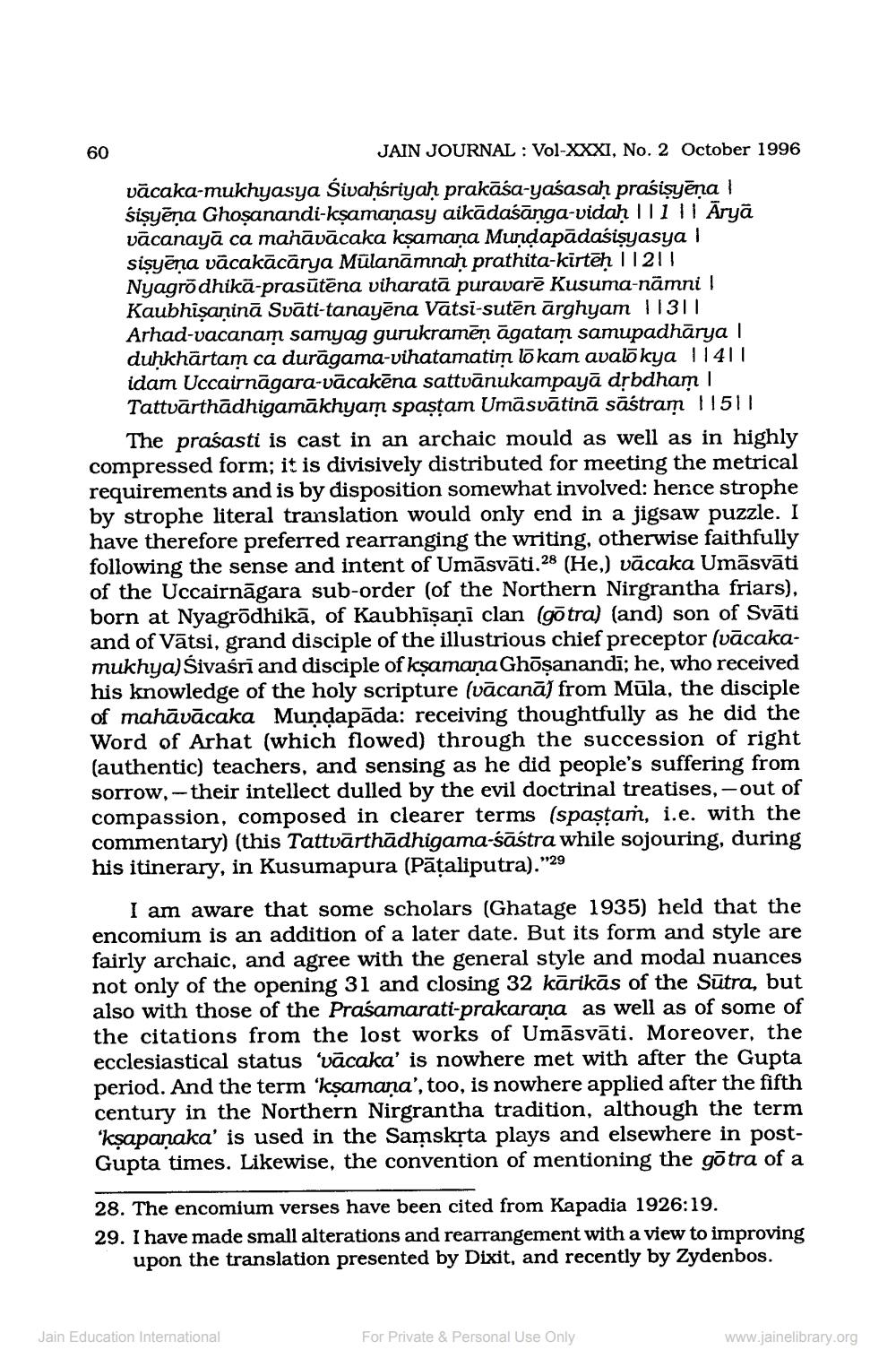________________
60
JAIN JOURNAL: Vol-XXXI, No. 2 October 1996
vācaka-mukhyasya Śivaḥsriyah prakasa-yasasaḥ prasisyēna | sisyena Ghoşanandi-kṣamanasy aikadaśānga-vidaḥ ||1|| Aryā vacanaya ca mahāvācaka kṣamana Munḍapādasiṣyasya | siṣyēņa vācakācārya Mülanamnaḥ prathita-kirtēḥ ||21| Nyagro dhika-prasūtēna viharata puravarē Kusuma-nämni Kaubhiṣaṇinā Svāti-tanayēna Vatsi-sutēn arghyam 11311 Arhad-vacanam samyag gurukramen āgatam samupadhārya | duḥkhārtam ca duragama-vihatamatim lokam avalo kya 11411 idam Uccairnagara-vācakēna sattvānukampaya dṛbdham | Tattvarthādhigamakhyam spaṣṭam Umäsvātinā sastram 1511
The prasasti is cast in an archaic mould as well as in highly compressed form; it is divisively distributed for meeting the metrical requirements and is by disposition somewhat involved: hence strophe by strophe literal translation would only end in a jigsaw puzzle. I have therefore preferred rearranging the writing, otherwise faithfully following the sense and intent of Umäsvāti.28 (He,) vācaka Umāsvāti of the Uccairnagara sub-order (of the Northern Nirgrantha friars), born at Nyagrōdhikā, of Kaubhiṣaṇi clan (gōtra) (and) son of Svāti and of Vatsi, grand disciple of the illustrious chief preceptor (vācakamukhya) Śivaśrī and disciple of kṣamana Ghōṣanandi; he, who received his knowledge of the holy scripture (vācana) from Mula, the disciple of mahāvācaka Muṇḍapāda: receiving thoughtfully as he did the Word of Arhat (which flowed) through the succession of right (authentic) teachers, and sensing as he did people's suffering from sorrow, their intellect dulled by the evil doctrinal treatises, -out of compassion, composed in clearer terms (spaṣṭam, i.e. with the commentary) (this Tattvārthadhigama-sastra while sojouring, during his itinerary, in Kusumapura (Pāṭaliputra)."
"29
I am aware that some scholars (Ghatage 1935) held that the encomium is an addition of a later date. But its form and style are fairly archaic, and agree with the general style and modal nuances not only of the opening 31 and closing 32 kārikās of the Sutra, but also with those of the Prasamarati-prakarana as well as of some of the citations from the lost works of Umāsvāti. Moreover, the ecclesiastical status 'vācaka' is nowhere met with after the Gupta period. And the term 'kṣamana', too, is nowhere applied after the fifth century in the Northern Nirgrantha tradition, although the term 'kṣapanaka' is used in the Samskṛta plays and elsewhere in postGupta times. Likewise, the convention of mentioning the gōtra of a
28. The encomium verses have been cited from Kapadia 1926:19. 29. I have made small alterations and rearrangement with a view to improving upon the translation presented by Dixit, and recently by Zydenbos.
Jain Education International
For Private & Personal Use Only
www.jainelibrary.org




